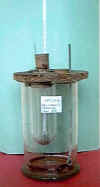![]()
 Museum
Museum
![]()
 SM244
Molecular depression of freezing point circa
1960 Heat
SM244
Molecular depression of freezing point circa
1960 Heat
Solidification is the passage of a substance from a liquid to a solid state. The phenomenon is explained with the following two laws:
(b) From the commencement to the end of the solidification, the temperature of a liquid remains constant.
Pure water solidifies at 0o C. But, when it contains a dissolved salt, the freezing point is depressed below 0o C. Blagdenís law states that the amount of depression is proportional to the weight of salt dissolved.
After the work of Raoult on temperature of solidification of solutions we can state that if P is the weight of substance dissolved in 100 grams of solvent and C is the depression of freezing point observed, then
![]()
where A is called the coefficient of depression or the depression produced by one gram of substance in 100 grams of solvent.
If we consider the molecular weight of the substance, the coefficient of molecular depression T, becomes
![]()
Now it is found in many cases that T is constant for a large number of substances in the same solvent. An apparatus that is used to obtain the molecular weight of a substance by the depression of freezing point consists of an outer vessel containing the freezing solution, and an inner tube having a side tube for introducing the sample. There is also a means of stirring the contents of the inner tube and a sensitive thermometer to record the freezing point. The inner tube is insulated by an air space from the outer vessel.
Vanít Hoff has shown that the coefficient of depression t may be calculated from
![]()
![]()